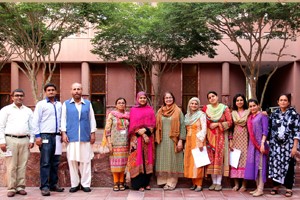Patients at the heart of teaching: A blended learning course experience
This story is written by Dr. Sameena Shah, Associate Professor Family Physician, Medical College, Karachi, Pakistan
“I am a consultant Family Physician at the Aga Khan University. In addition to being a clinician, I am also a teacher, and I love what I do.
Since 2012, I have been working extensively to develop and establish palliative medicine services including ‘end of life care’ at the Aga Khan University Hospital. As an emerging area in Medical Education in Pakistan, in order to increase capacity at AKUH and AKHSP, I have designed and developed regular face-to-face courses and workshops on Palliative Care for postgraduates and physicians.

In 2013, I participated in the Faculty Development Programme for Blended Learning.
My participation in the programme equipped me to use online pedagogies to reach physicians remotely in areas such as Interior Sindh, Gilgit-Baltistan, Karachi and AKU residents both on and off-campus.
Providing awareness about the human dimension of patients to ensure their holistic wellbeing and care has always been at the core of my teaching. In addition to the scientific side of medicine, students need to be sensitive to their patients’ and patients families’ socio-cultural and emotional dimensions to be able to facilitate effective care and management in clinical settings and indeed the community.
Previously, I used to role-play and presentations to teach core concepts. With the blended learning approach, I now create ‘online’ patient stories as a resource to organise a number of teaching and learning activities.
To ensure holistic and patient-centred learning I have created varied socio-economic and cultural settings for each patient that highlight key issues. Moreover, I have included lab reports, radiological investigations and hand-written prescriptions as part of the patients’ narratives.
Towards the end of the course, students participate in a practical component where they visit a hospice and observe clinical consultations in real-time. The course concludes with a workshop based on the patient stories to teach and practice counselling skills through evidence-based role-play strategies.
Through fictionalising real-life accounts and encouraging students to review them not only as clinical scenarios but ‘stories’, routinely moderating discussions and reasoning on online discussion forums, presenting students with probing questions and clarifying concepts, the patient’s life is at the centre of teaching and learning activities.
Feedback highlighted the usefulness of “interdependence” in discussions where participants were able to learn from each other. They appreciated the way patient stories were presented with the incorporation of sensitive issues, and how visuals such as reports and prescriptions were added.
However, a few of the participants felt that the interaction on online discussions could be improved by more faculty member and peer input and more frequent live summary sessions for clarification of queries. This did strike a chord, as a challenge with this methodology for me has been establishing an adequate view of students’ progress, due to the asynchronous nature of discussions. However, reviewing students’ responses is always helpful to understand what they have learned and where they need assistance.
It was a learning curve, but by the end of discussions, I was able to ascertain the level of understanding of my students. Another challenge is structuring the task with relevant questions, activities and visual details so as to make it as real as possible. Linking it to the objective of the course and at the same time giving enough freedom to students to think and work independently is yet another challenge. I overcome these challenges by detailed planning and provision of pre-reading material to help students to come prepared to the (online) and classroom lectures.
I also want to highlight the importance of professional development in designing a course in such an innovative format; I learned by doing! Faculty mentors and course designers at the Network of Blended and Digital Learning provided me with strong pedagogical knowledge about blended learning, provided feedback on course design and developed digital learning artefacts for this course. Another important aspect to my learning was reflective conversations where course designers would ask me difficult but interesting questions on why I would like to design and teach a concept in a certain manner, how learning materials should be presented or how it can enhance students’ engagement in learning. Moreover, we would critically reflect upon the challenges and collaboratively devise strategies to overcome them for the next offerings of the course.
Based on my experiences, I recommend that we should attempt to make our teaching more patient-centred in content and clinical practice and include more student-centred in teaching and learning activities. It is also important to make changes in the courses as per student feedback.”


